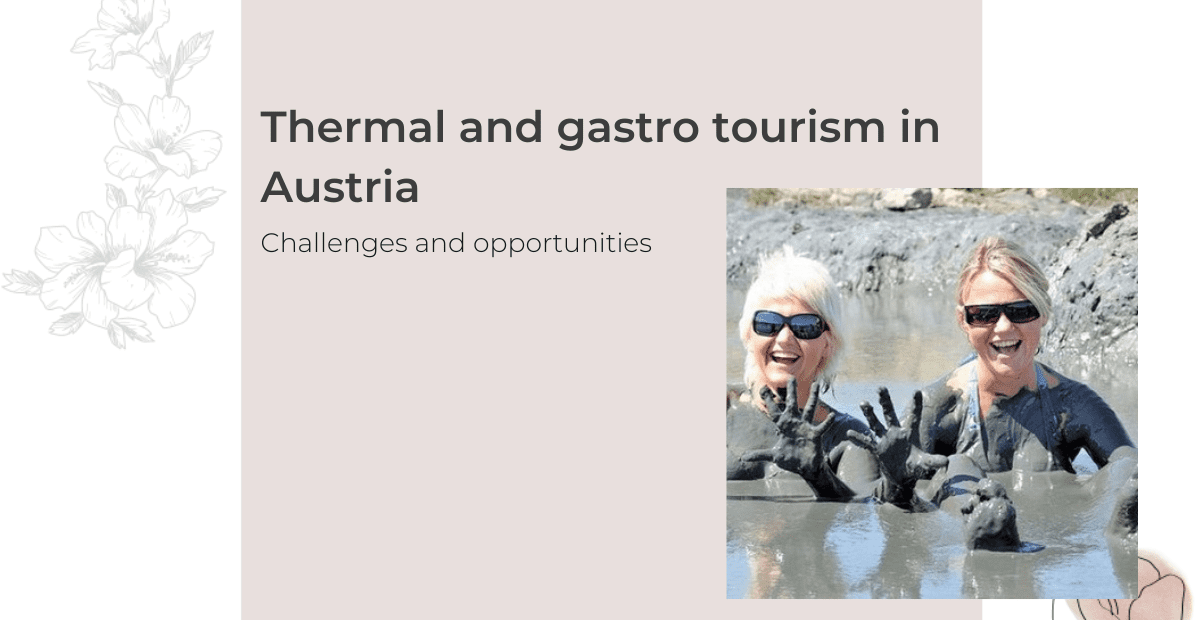Thermal and gastro tourism in Austria

Economic situation of thermal spas and gastronomy in Austria
The covid pandemic severely affected the thermal spas and gastronomy. If one considers that around 10 million people visit Austrian thermal spas every year, one can imagine how important this branch of the economy is and how many jobs it creates in the respective regions.
Due to the covid pandemic, revenue from admission fees to thermal spas in Austria fell from €162.15 million in 2019 to €93.87 million in 2020 and €102.35 million in 2021, with revenue of €160.63 million forecast for 2022.
In this context, the government’s decisions regarding the Corona policy were strongly criticised, because the hotel and restaurant industry was strongly supported by the reduction of the tax rates on accommodation and on beverages and food (5 %). However, spa admissions were not. Here, only the Corona short-time working model took effect. In this regard, it must be noted that only establishments that did not have more than one million euros in turnover in November 2019 did well. In fact, it was stipulated that businesses in the leisure industry would get 80 per cent of their November 2019 turnover replaced. This amount was set at a maximum of 800,000.00 euros.
Due to the lockdowns, which were mainly imposed in the winter season, this industry lost income in the period with the highest turnover.
After an economic recovery of this industry was in sight with 2022, this prospect does not seem to come true due to the energy crisis. This will result in a price increase of up to 15 % for entry fees.
Challenges of the sector
One of the major challenges the sector is facing is the energy crisis in Europe resulting from the Russian invasion in Ukraine. The rise of prices for energy is changing the budget of the tourism companies and thus prices for customers are going up, resulting in less clientele.
Some ideas to solve the energy challenges are:
- Conversion of combined heat and power plants to biomass power plants
- Installation of photovoltaic systems
- Temperature reduction
- Reduction of value-added tax from 13 % to 10 % demanded
- Increase in prices
- Closure of parts of public baths
- Use of hot water for energy production
Another major challenge the sector is facing is staff shortage:
“Closed due to lack of staff!” This is what you often read in Upper Austria at catering establishments.
According to a report by the AMS, there is a shortage of up to 15,500 employees in the hotel and restaurant industry. The branch even assumes a shortage of 35,000 employees.
Many people are looking for employment opportunities in other sectors of the economy and due to the covid pandemic, fewer foreign workers came into the country.
This trend has resulted in reduced opening hours as well as menus with fewer offerings.
Employment opportunities and employment challenges
As mentioned above, finding and retaining employees is a challenge. Big tuierober results in new employees who are not always trained and need more attention from managers. hiring under qualified employees might result in poor customer service.
Some ideas to to solve the staff problems are:
- Introduction of a four-day week
- Introduction of online reservation systems and chatbots
- Use of a smart telephone assistant
- Table ordering via QR code
- Use of digital shift plans
Most of these ideas are related to the need of the sector to go digital – tourism has been one of the sectors who is slow to adopt digital solutions and embrace digital transformation. While the sector heavily relies on human interaction, post pandemic reality and energy crises are calling for change.
Business owners in the tourism sector must understand that human interaction will not be lost if digitization is done properly. Routine questions, reservations can be done without queuing in a fast and efficient way. Interaction in the spa, restaurant and reception can still happen on important matters which AI and chatbots cannot handle. Thus interaction will be improved, employees will not be overwhelmed with routine questions.
Best practices for finding staff and promoting the business
In order to specifically search for and approach employees, the resmio marketing team recommends on their website that companies should already be convincing when advertising a job and refer to the StepStone report “Employer attractiveness” from 2020. This shows that the following criteria are particularly important when choosing a job:
- Corporate culture
- Career and further training opportunities
- Meaningful tasks
- Flexible working hours
- Salary (other financial benefits)
It is also important that job advertisements are not only posted on the front door, but also online and offline.

